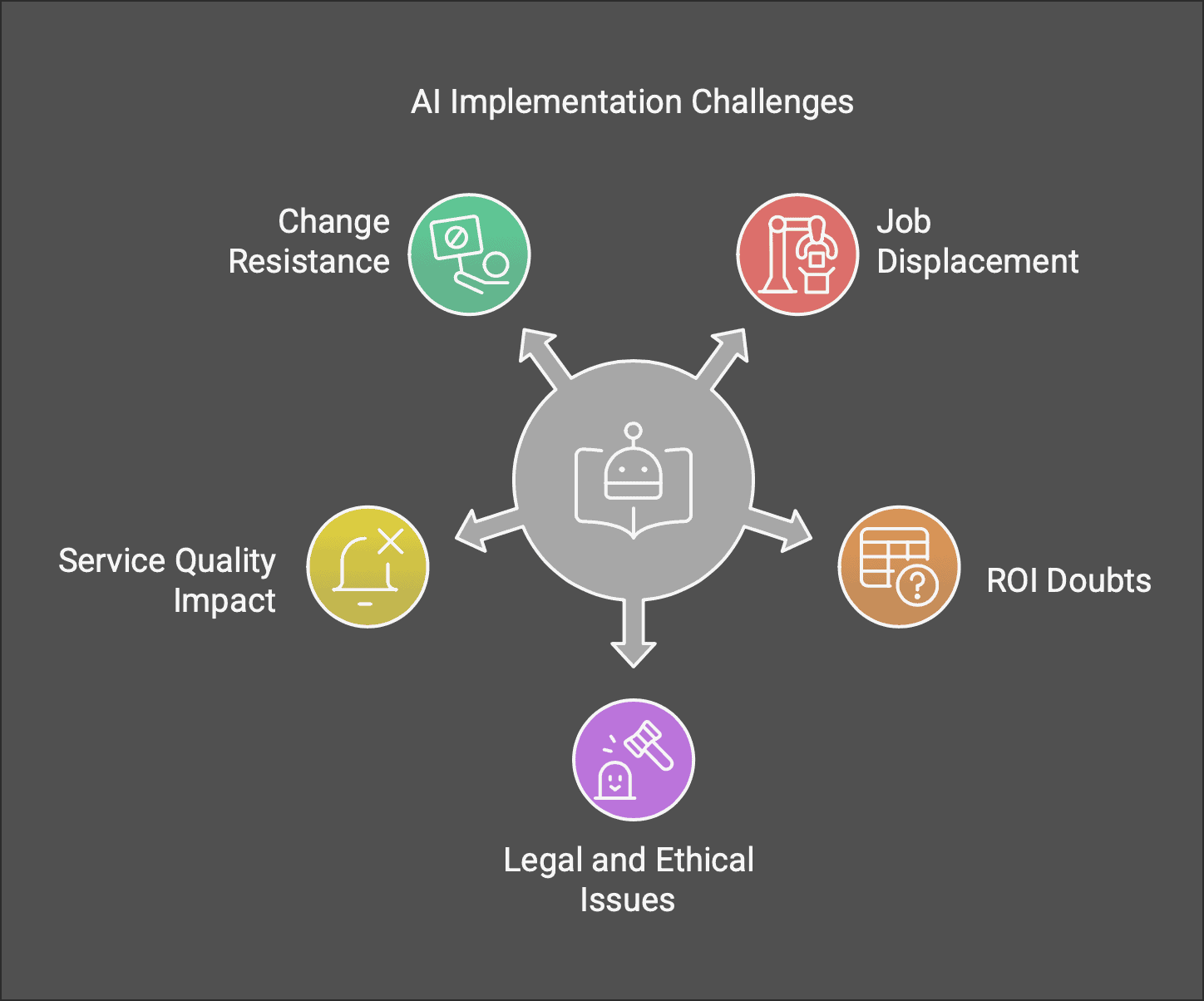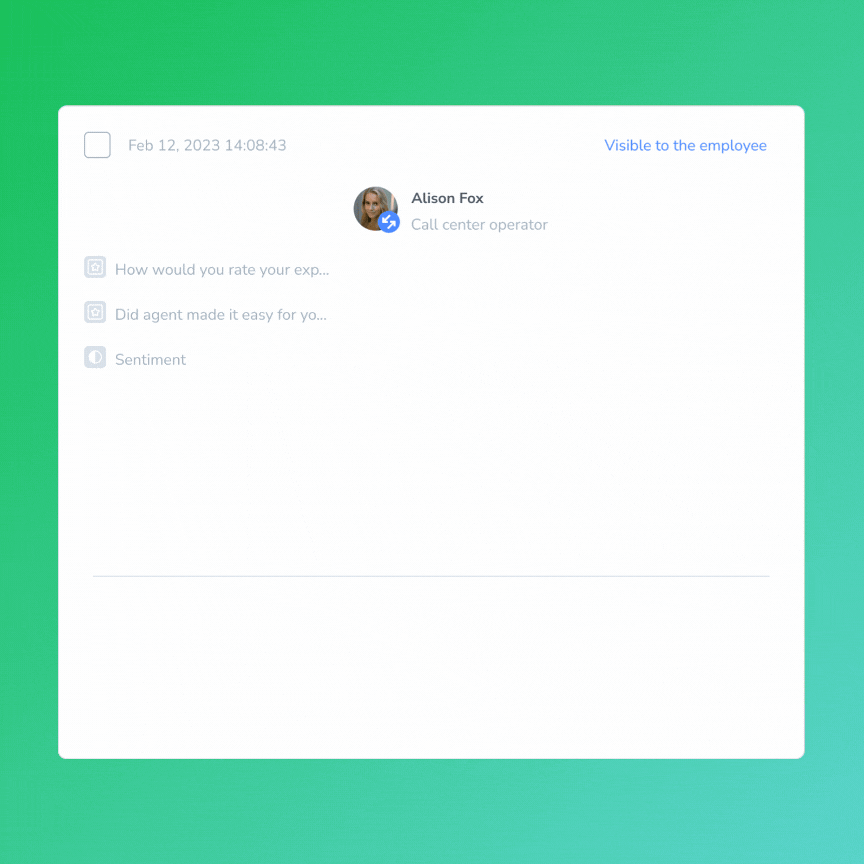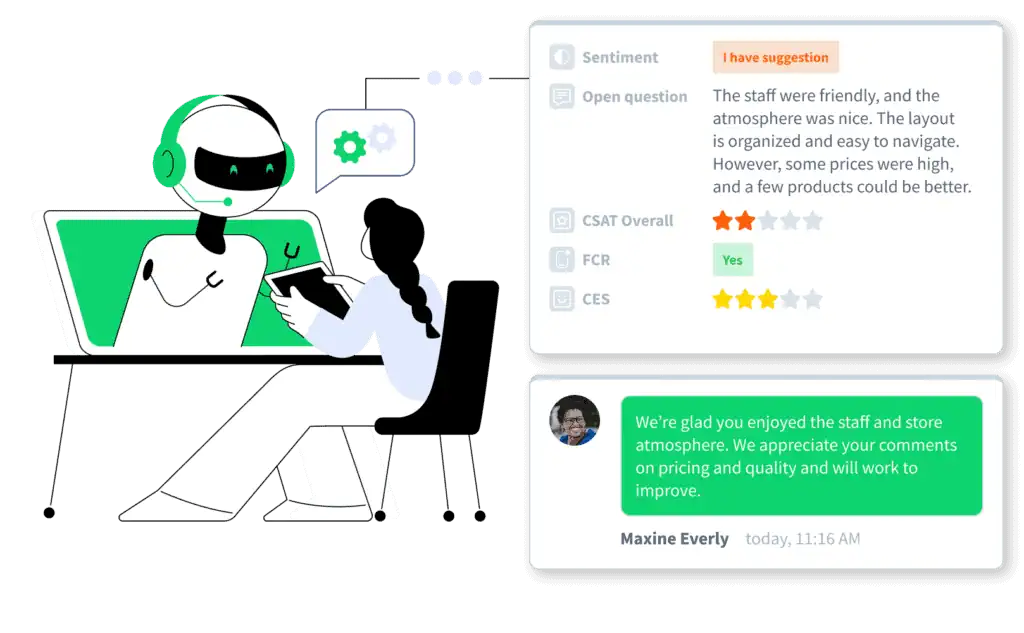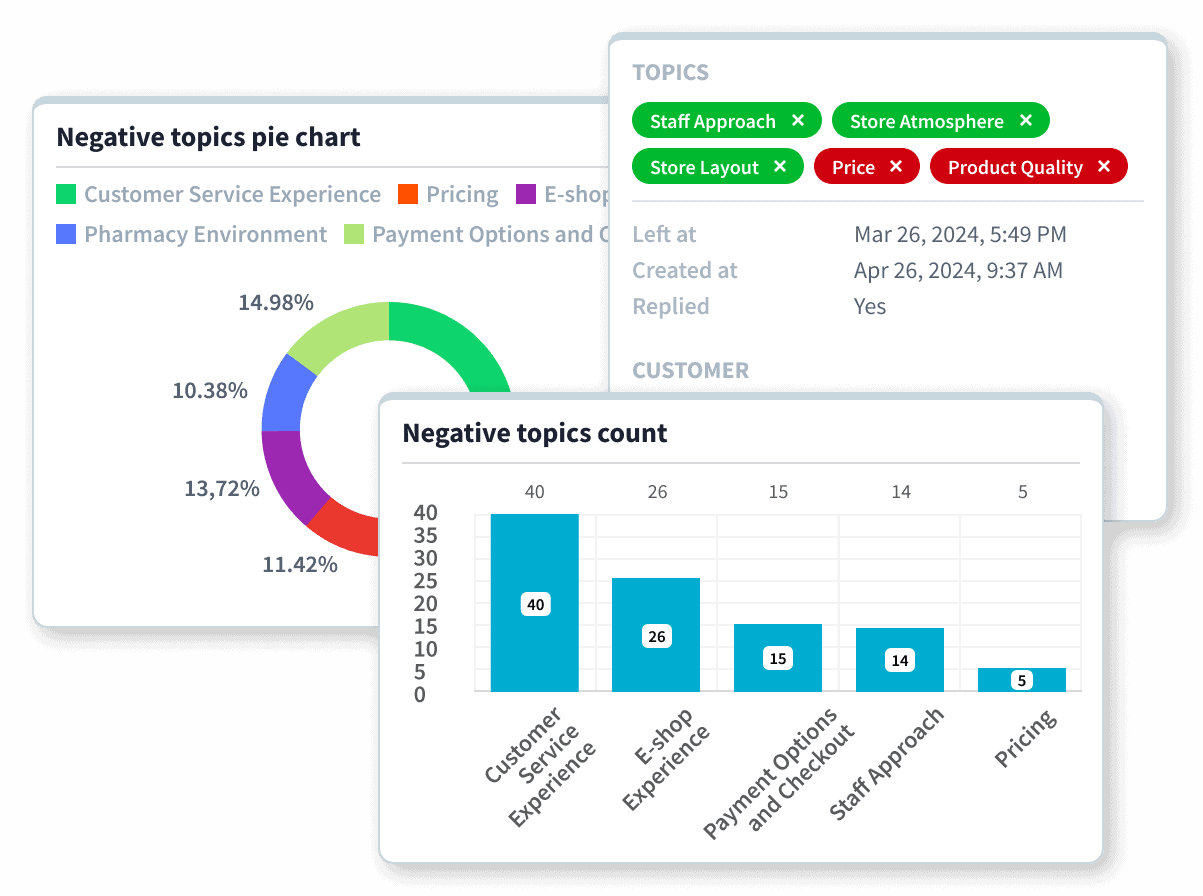AI is transforming customer and employee experience, making processes more efficient, improving customer satisfaction, and freeing teams from repetitive tasks. Yet, despite its clear benefits, many businesses hesitate to adopt AI due to common fears and misconceptions.
Will AI replace jobs? Is it too difficult to implement? Will it really be worth the investment? What about data security? And can AI truly maintain a high level of customer service?
In this guide, we tackle the five most common fears about AI adoption and show how, when implemented correctly, AI is not a risk—it’s an opportunity for smarter, more effective CX management. Whether you’re a manager introducing AI to your team or an employee advocating for AI’s benefits, this guide will help you communicate AI’s actual value and ensure a smooth transition.

Fear #1: “AI Will Replace Me”
Concern
The fears of AI’s impact on the jobs economy are a major topic, and job displacement is one of the biggest fears around AI. Employees worry that AI will take over their roles, especially in repetitive tasks, while managers fear losing control or even their own relevance. The assumption is that once AI is in place, people will be left without meaningful work, leading to layoffs or reduced job security.
Reality Check: AI Enhances, Not Replaces
AI is not here to replace people—it’s here to free them from repetitive, low-value tasks so they can focus on more meaningful and strategic work. AI acts as an assistant, handling routine tasks like feedback categorisation, sentiment analysis, or KPI tracking, allowing teams to spend more time on problem-solving, coaching, and improving customer experience.

Think of AI as a power tool: It doesn’t replace the carpenter—it helps them work faster and with greater precision. Instead of removing jobs, AI makes existing jobs better by reducing stress and inefficiencies. Companies using AI-powered CX tools often see improved performance and job satisfaction, as employees can focus on customer interactions that truly matter.
How to Communicate It in Your Organisation?
- For managers talking to their teams:
“AI is not here to replace you but to help you. It will handle the time-consuming, repetitive parts of your job so you can focus on higher-value tasks. This means fewer frustrating manual processes and more opportunities to develop skills, provide personalised service, and make a bigger impact in your role.”
To reinforce trust, involve employees in the AI implementation process. Show them how it supports their work rather than taking it away. Transparency is key.
- For employees talking to their managers:
“This AI tool isn’t about doing less work—it’s about doing better work. By automating routine tasks, we can spend more time improving customer satisfaction, resolving complex issues, and working on initiatives that directly impact business success. Instead of worrying about AI replacing us, we should focus on how it helps us be more effective.”
Employees can also highlight real-world benefits: faster response times, less burnout, and more opportunities for professional growth. The key is positioning AI as a support system rather than a threat.
Fear #2: “Our Team Won’t Accept AI”
Concern
People naturally resist change—especially when it involves new technology. Employees may fear AI will complicate their work, add pressure, or make their contributions less valuable. Managers might fear slow adoption or pushback from staff who are comfortable with existing workflows. The assumption? AI implementation will be more trouble than it’s worth.
Reality Check: AI Adoption is About Enablement, Not Disruption
Resistance to AI usually comes from uncertainty, not inefficiency. The key to overcoming this fear is clear communication and demonstrating quick wins. AI tools like Staffino’s help streamline workflows without forcing employees to completely change how they work.
When implemented correctly, AI reduces frustration, eliminates tedious manual work, and allows employees to focus on tasks that require human expertise. Companies that introduce AI gradually—rather than as an abrupt overhaul—see higher acceptance rates and engagement.
How to Communicate It in Your Organisation?
- For managers talking to their teams:
“We’re introducing AI to make your job easier, not harder. It will handle repetitive tasks like sorting feedback and responding to routine customer inquiries, so you have more time for meaningful interactions. This means less stress, faster response times, and more time for tasks that actually make a difference.”
Managers should highlight personal benefits: reduced workload, fewer repetitive tasks, and a focus on engaging work. Provide real examples of how AI improves daily operations—small wins build confidence.
- For employees talking to their managers:
“Using AI doesn’t mean we do less—it means we do better. By letting AI handle the repetitive parts of customer feedback management, we can focus on resolving critical issues, improving CX, and delivering real value. Instead of seeing AI as a disruption, we should see it as a tool to enhance what we already do well.”
Employees can also frame AI as an efficiency booster rather than a workflow disruptor. Position it as a way to improve response times, increase customer satisfaction, and free up time for strategic initiatives.
Fear #3: “Will AI Really Be Worth the Investment?”
Concern
One of the biggest reasons why businesses are scared of AI is the return on investment (ROI). Will the cost of AI tools actually translate into real savings and business growth? Or will it just be another expensive experiment with unclear benefits?
Managers often struggle to justify AI spending, especially when manual processes feel “good enough” or when past tech investments didn’t deliver as promised. The fear? AI won’t pay for itself, and budgets will be wasted.
Reality Check: AI Pays for Itself—And Then Some
AI isn’t an expense—it’s an efficiency multiplier. The right AI solutions reduce operational costs, free up employee time, and improve customer experience, leading to higher retention, satisfaction, and revenue.
With Staffino’s AI tools, companies replace slow, manual processes with intelligent automation, saving both time and money. And unlike hiring more employees to handle increasing workloads, AI scales instantly—without additional overhead costs.
ROI in Action: The Numbers Speak for Themselves
Let’s use real numbers to illustrate the ROI of our AI feedback response generator.

Manual feedback handling cost:
- 5 employees handling feedback responses
- €2,500/month per employee (an estimate based on the average monthly gross salary in Europe)
- Total cost: €12,500/month
AI Feedback Responder Cost:
- Starts at €800/month (+ one-time setup fee)
- Fully autonomous or €1,500/month with human review
- Total cost: €5,000/month (with human review)
Results:
- 60% cost savings (€7,500/month)
- Faster response times, improved CX, and better team efficiency, which increase revenue
How to Communicate It in Your Organisation?
- For managers talking to their teams:
“Investing in AI is about improving efficiency and results, not just cutting costs. Instead of spending hours on repetitive tasks, your team can focus on more impactful work. AI allows us to scale without adding unnecessary workload, giving customers faster responses and better experiences.”
Managers should communicate that AI is a long-term investment in productivity, not a short-term cost. When employees understand that AI makes their work easier, not redundant, they’ll embrace it faster.
- For employees talking to their managers:
“AI isn’t just about automation—it’s about smarter work. Instead of spending time on repetitive feedback handling, AI allows us to focus on real problem-solving and customer engagement. The time we save can be reinvested into areas that directly impact business growth.”
Employees should highlight that AI doesn’t replace human value—it enhances it. The faster tasks are completed, the more time remains for high-impact work that drives customer loyalty and revenue.
Fear #4: “Is AI Even Safe? What About Data Privacy and Compliance?”
Concern
Many businesses hesitate to adopt AI due to legal and ethical concerns. They worry about data privacy, regulatory compliance, and responsible AI use. They have questions like:
“Will AI handle customer data securely?”
“Are we risking GDPR violations?”
“Can we trust AI to make fair and unbiased decisions?”
Since AI often deals with sensitive customer and employee data, companies are understandably cautious—no one wants a compliance nightmare.
Reality Check: AI Can Be Safer Than Manual Handling
When implemented correctly, AI is not a security risk—it’s an upgrade in data protection and compliance. Unlike manual processes, which rely on human discretion (and human error), AI can ensure consistent, unbiased, and regulation-compliant handling of sensitive information.
At Staffino, data security and compliance are top priorities. Our AI tools are fully GDPR-compliant, with strict data access controls and encryption to keep customer data safe. Plus, AI can actually reduce human error, ensuring that personal information is handled consistently and within regulatory frameworks. If you want to learn more about concrete ways we ensure AI safety, check out this PDF with the most frequently asked questions and answers about Staffino AI tools’ GDPR compliance.
Instead of relying on individual employees to manually enforce compliance, AI applies consistent, automated rules for data processing, retention, and anonymisation. Here’s how AI improves data security and compliance:
- GDPR-compliant – AI ensures all data is handled according to regulatory requirements, reducing legal risks.
- Consistent data processing – No risk of employees mishandling sensitive feedback or making subjective decisions.
- Advanced encryption & access controls – AI tools can restrict access and protect sensitive information better than manual processes.
- Audit trails & transparency – AI logs every action, making compliance audits faster and easier.
How to Communicate It in Your Organisation?
- For managers talking to their teams:
“AI doesn’t mean compromising on security—in fact, it can enhance it. With built-in compliance measures, AI ensures that customer feedback is handled consistently and securely, without the risk of human errors or data mishandling.”
Managers should emphasise control and transparency—teams can monitor AI actions and adjust settings to meet compliance needs. Instead of increasing risk, AI reduces it by ensuring consistency in how data is processed and stored.
- For employees talking to their managers:
“AI isn’t a black box—it’s a controlled system that operates within strict security guidelines. By automating feedback handling, we reduce the risk of human errors, data leaks, and inconsistent compliance practices. Instead of worrying about AI replacing human oversight, we should see it as a tool that makes compliance easier and safer.”
Employees can also highlight that AI doesn’t operate in isolation—it works alongside humans, ensuring that final decisions and oversight remain in human hands when necessary.
Fear #5: “Will AI Hurt the Quality of Our Customer Experience?”
Concern
Many businesses considering artificial intelligence fear that AI-driven automation will make customer interactions robotic, impersonal, or error-prone, as is often the case with many chatbots. The fear is that AI might misunderstand customer sentiment, provide generic responses, or struggle with complex cases—ultimately harming CX rather than improving it.
Managers fear that relying on AI too much could damage brand reputation, while employees worry they’ll lose the ability to connect with customers personally.
Reality Check: AI Enhances the Quality of Human-Led CX
When AI is implemented correctly, it improves speed, consistency, and accuracy, ensuring higher customer satisfaction without losing the human touch. It also provides better, error-free insights for personalised service.
For example, Staffino’s AI Feedback Responder doesn’t just generate generic messages—it crafts personalised, context-aware responses while ensuring brand voice and tone stay consistent across all interactions. AI also helps CX teams flag and prioritise the most important cases, so human agents can focus on high-value interactions instead of repetitive tasks.
So, instead of lowering CX quality, AI actually enhances it by:
- Ensuring faster response times – No more long wait times; AI instantly acknowledges and processes feedback.
- Providing consistent, on-brand messaging – No more variation in tone and style—every response aligns with company standards.
- Personalising interactions at scale – AI uses customer history and customer sentiment analysis to craft responses tailored to each customer.

- Freeing up agents for complex cases – Instead of handling repetitive questions, employees can focus on customers who need human support.
How to Communicate It in Your Organisation?
- For managers talking to their teams:
“AI is here to improve how we engage with customers, not to make interactions robotic. It takes care of repetitive tasks so that you can focus on meaningful conversations that truly make a difference. Faster response times, personalised feedback, and data-driven insights will help us create even better customer experiences.”
Managers should highlight that AI doesn’t remove human input—it helps teams deliver better service faster. Instead of treating AI as a “replacement,” show how it elevates the customer experience by removing inefficiencies.
- For employees talking to their managers:
“AI helps us respond to more customers in less time while keeping interactions personalised and relevant. It ensures that no feedback gets lost, and it helps us focus on solving real issues instead of repeating the same manual responses over and over. The result? Happier customers and more engaging work for us.”
Employees should emphasise that AI is now much more advanced and far beyond the abilities of infamous chatbots. By taking care of repetitive tasks, AI allows them to spend more time providing high-quality customer service where the human touch is truly needed.
Conclusion
Adopting AI isn’t about replacing people—it’s about empowering them. As we’ve debunked the most common fears around AI tools for CX management, one thing is clear: when used correctly, AI enhances efficiency, customer satisfaction, and business growth while reducing costs and repetitive work.
AI isn’t something to fear—it’s something to leverage. The businesses that don’t fear artificial intelligence and embrace it today will be the ones leading CX innovation tomorrow.
Ready to see the impact for yourself?

Experience Management Made Smart
Boost your business performance with Staffino – the ultimate platform to deliver unique experiences for your customers and employees.









